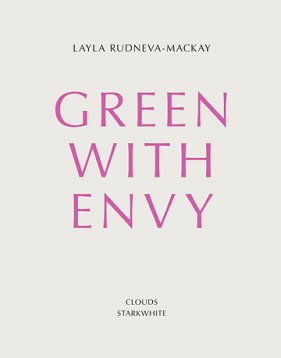John Hurrell – 31 March, 2013
As for the writing in this book, it is really disappointing. It seems devised to avoid dealing directly with the photography. The discussion is about everything but Rudneva-Mackay's art - as if the subject were an embarrassment or an obscenity, preferring to discuss ornithology or drawing or other irrelevancies. It's a shame because her photographic work is so rich; it cries out for some articulated conversation, some elucidated thought that zeros in on its details and methods.
Layla Rudneva-Mackay
Green with Envy
Essays by Gwynneth Porter, Jon Bywater, Sean O’Reilly, Layla Rudneva -MacKay, and Selene Forester.
Editor: Gwynneth Porter
Design: Warren Olds
Coloured illustrations, 124 pp
Published by Starkwhite and Clouds, 2012
In this beautifully designed softcover book - a treat to hold and open - we can see the variety of photograph Layla Rudneva-Mckay specialises in: standing figures in a landscape that are hidden behind held-up towels or sheets; leaning bodies covered with hooded garments and covered limbs; posed clothed models with the skin of their limbs or faces hidden behind coloured make up; buildings photographed at night with no eternal illumination; children’s dwellings or forts in sitting rooms made with cushions or stacked or upended furniture.
They are all very strange and amusing - akin to the improvised ‘pencil’ photographs of Paul Cullen or Erwin Wurm’s images of bodies and objects. They are a pleasure to think about - mysterious, eccentric and funny. Lots of conceptual angles.
As for the writing in this book, it is really disappointing. It seems devised to avoid dealing directly with the photography. The discussion is about everything but Rudneva-Mackay’s art - as if the subject were an embarrassment or an obscenity, preferring to discuss ornithology or drawing or other irrelevancies. It’s a shame because her photographic work is so rich; it cries out for some articulated conversation, some elucidated thought that zeros in on its details and methods.
Looking at the five writers, the closest thing to being useful is the book’s title which references colour that symbolises personality types, and Jonathan Bywater’s essay which partially describes a divided landscape (forked river, split rocks) as an allegory for biculturalism. The irrelevent texts are a wasted opportunity.
Here are a few of the images. The prevalent theme seems to be that of the hidden, or the blocking off of visual access to the ‘natural’, raw or ‘uncooked’. Plus they allude to a wide range of other topics including privacy, childhood, domesticity, shelter, Shakespearean theatre, human epidermis, race and physiognomy.
I think there are heaps of writers who could comment brilliantly on these images, so it is a shame the editor hasn’t sought out some good ones for commissioning, for with appropriate and focussed writing this could have been a really valuable publication. Still it’s great to see fifty of Rudneva-Mackay’s highly stimulating images together in a book. That at least allows us to think about them en masse at leisure.
John Hurrell

 Advertising in this column
Advertising in this column Two Rooms presents a program of residencies and projects
Two Rooms presents a program of residencies and projects



This Discussion has 0 comments.
Comment
Participate
Register to Participate.
Sign in
Sign in to an existing account.